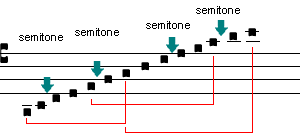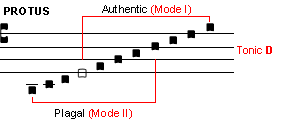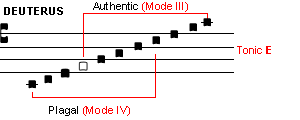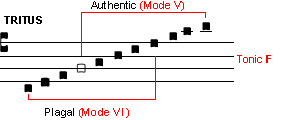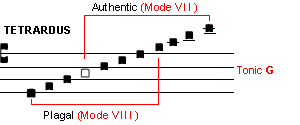
| LESSONS
ON GREGORIAN CHANT |
LESSONS ON The only diatonic scale which Gregorian Chant is served, is the following one (think of the piano white notes):
Not all the melodies cross this extension: someone of them are kept in the low eighth (from A to A), others in the medium (from E to E) and others in the Superior (from G to A). In each of these octaves, the SEMITONES are far more or less from the final note, which is a fundamental element to understand the modes. For the Greek-Romans, the octave that we know today did not exist. They were rather two tetrachords separated or simply juxtaposed: C, D, E, F The tethrachord is considered to be the modal base, that is to say, the first completed element or generating nucleus of the whole melody.
The same thing happens with the superior tethrachord. Have in mind that, in contrast to the current music, in Gregorian Chant scales do not exist in that, on having changed a tonality to other one, or a major mode to a minor one, in order for the semitones to stay in the same place, it is necessary to use the sharp or flats signs. These scales include a central fifth from the tonic note, called also final note, plus three sounds be already in the top part in which case they are called authentic (sharp) modes, or in the low one, and in this case modes are called Plagals (serious). The names of these modes are:
There exists a tonic note in which, although not always the melody begins in, in her she ends and rests commonly. As it is seen in the previous picture, four could be the tonic notes: D, E, F, G which are represented by the white notes. Besides, in every mode there is a dominant note so called because the melody returns to this one with relative frequency. The dominants are:
Each of these modes has a peculiar character, due to the different laying of the semitones —as it was said already— and consequently its own expressive power. In consequence, one can differentiate the modes for:
There can be transposed, combined and sometimes free modes. The mode in which a Gregorian piece is composed sometimes is indicated by a number located before the first stave. The example shows that the antiphon is written in the eighth mode .
Nevertheless it is necessary to note the following: The 8 modes theory of the Middle age was adapted to the repertoire that already existed previously, that is to say that the Gregorian pieces were not created having in mind the allocation to a certain mode. A serious analysis of the Gregorian and of the ambrosian melodies, makes us to conclude that it was neither the modal criterion nor the technical principle those that were in the primitive Gregorian Chant composers' mind, though it is necessary to accept that in late compositions effectively this theory of 8 modes was followed. Dom Gregorio Suñol O.S.B. notes down in the matter: (1) “Its is necessary to recognize that: a) In many pieces the eighth is incomplete. Ej. Antiphon "Dixit Dominus". b) In the fourth mode the relation of octave is never complete, that is from lower natural B to upper natural B, case that would be enough by itself to doubt about the whole rest of that theory. c) In the interval of fifth which is common for authentic and plagal modes, the interval on the tonic is absent often and therefore, it is not possible to classify accurately the mode for not differing therefore the third minor G-E (third mode) and F-D (first mode). d) In some melodies finishing touches of later epoch are discovered; for example, in the type of "Proprio filio" (Friday of Holy Week). e) In others it is necessary to recognize passages, we will say “chromatics” that they do not agree with the theory of the Middle age above exposed: for example, in the antiphon “Urbs fortitudinis”, in the communion “Passer invenit” and in the “Beatus vir ”. f) In lot of melodies, what is called as own respective tonic does not appear any more except in the last note, being absent therefore the modal logic; for example in the antiphon "Maria et flumina" of the Epiphany. g) In many pieces it might be easy to change the final note without the general design of the piece suffering damage; this is what happens to the previous antiphon in relation to “In illa dies” of the first Advent sunday, in which it is easy to replace the G with E. h) Concerning to the dominant of a mode, it appears often scarcely in the whole piece or simply it is completely absent, and also that in every clause or member of phrase it is possible to observe being different the central or dominant note. This way it turns out to be a constant modulation, opposite to ostensible modal unit of the Middle age”. Even more: in some cases one can found melodies that were modified in order that they could be shaped by the theory of eight modes. Some primitive sources contain antiphons for psalms that do not adjust to the system and sometimes it is possible to see that the same melody has been altered later to assure his conformity. Such is the case of the antiphon “Cantabimus et psallemus virtutes tuas, Domine”. Primitive melody: C, C, C, B, C, A, G, B, A, B,
C, A, G, A, C, D, B
DO THE MODES EXPRESS FEELINGS? Some authors have tried to assign to every mode specific characteristics as for the expressive sense that describe them. This quality has been named the modal “ethos”. Guido D'Arezzo says: “The first is serious, the second is sad, the third is mystic, the fourth is harmonious, the fifth makes happy, the sixth is devout, the seventh angelical and the eighth is perfect”. Adam de Fulda comments about the modes: “The first mode lends to any feeling, the second is suitable for the sad things, the third is vehement, the fourth has tender effects, the fifth is convenient for those who are happy, the sixth for those of proven piety, the seventh belongs to the youth, the eighth one to the knowledge ”. Juan de Espinoza, author on the XVIth century, comments: “The First is quite happy and very skilful to tame the passions of the soul ...; serious and tearful is the Second, much adapted to provoke tears ...; the Third is very effective to incite to anger ...; whereas the Fourth takes in himself any happiness, and incites to the delights and moderates the fierceness ...; the Fifth causes happiness and pleasure to those who are in sadness ...; tearful and pious is the Sixth ...; pleasure and sadness meet in the Seventh ...; for force the Eighth mode has to be very happy ... ” (Treaty about principles, of 1520). __________ (1) SUÑOL, Gregorio Ma. O.S.B., Método completo de Canto Gregoriano según la escuela de Solesmes, Monasterio de Monserrat, 1943. (2) "The eight gregorian modes": http://www.beaufort.demon.co.uk/modes.htm © Reproduction in whole or in part is prohibited
without the author's expressed authorization. |
![]()
Theory
and Technic | Canticum
Novum | Didactic
Concerts |
Links
History | Characteristics
| Notation | Modes
| Rhythm | Chironomy
| The psalmody |
| Latin pronuntiation |
Translations & scores|
Bogotá/Colombia - 2002
